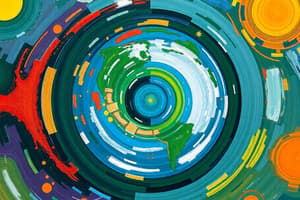Podcast
Questions and Answers
Based on the drawing, what season are students in Florida experiencing when Earth is at position 1?
Based on the drawing, what season are students in Florida experiencing when Earth is at position 1?
- Spring
- Summer (correct)
- Fall
- Winter
What would be the resulting condition if the Earth's axis was perpendicular to the sun?
What would be the resulting condition if the Earth's axis was perpendicular to the sun?
There would no longer be seasons.
How do the days for each hemisphere compare during the summer solstice in the northern hemisphere?
How do the days for each hemisphere compare during the summer solstice in the northern hemisphere?
The northern hemisphere will experience a day with the most amount of sunlight while the southern hemisphere will experience a day with the least amount of sunlight.
What does Galileo's statement indicate about scientific information?
What does Galileo's statement indicate about scientific information?
What does Ms. Jancy want her students to learn from modeling the solar system on the running track?
What does Ms. Jancy want her students to learn from modeling the solar system on the running track?
Why are different portions of the moon visible at different times of the month?
Why are different portions of the moon visible at different times of the month?
What is the difference between a solar and lunar eclipse?
What is the difference between a solar and lunar eclipse?
Which phase will the moon be in when viewed from Earth based on the diagram showing the Earth between the moon and the sun?
Which phase will the moon be in when viewed from Earth based on the diagram showing the Earth between the moon and the sun?
What phenomenon caused the circular shadow on the moon observed by Aristotle?
What phenomenon caused the circular shadow on the moon observed by Aristotle?
What kind of information will Noel's model NOT be able to demonstrate?
What kind of information will Noel's model NOT be able to demonstrate?
Which group most accurately modeled the motions of the Earth, moon, and sun?
Which group most accurately modeled the motions of the Earth, moon, and sun?
Which two of the four moon positions will cause the neap tides?
Which two of the four moon positions will cause the neap tides?
What observable phenomena naturally results from the moon's orbit?
What observable phenomena naturally results from the moon's orbit?
Why is the moon's gravity able to influence high and low tides?
Why is the moon's gravity able to influence high and low tides?
Which process is most difficult for scientists to perform when learning about the solar system?
Which process is most difficult for scientists to perform when learning about the solar system?
What do you predict will be the pattern for the tides on January 8, 2004?
What do you predict will be the pattern for the tides on January 8, 2004?
Why are summer days longer than winter days on Earth?
Why are summer days longer than winter days on Earth?
Earth makes one full rotation in its axis approximately every ______ hours.
Earth makes one full rotation in its axis approximately every ______ hours.
Flashcards are hidden until you start studying
Study Notes
Earth and Seasons
- When Earth is at position 1 in its revolution around the sun, Florida experiences summer.
- If Earth's axis were perpendicular to the sun, there would be no seasons.
Solstices and Sunlight
- During the summer solstice in the Northern Hemisphere, sunlight is at its maximum, while the Southern Hemisphere experiences minimal sunlight.
Scientific Inquiry
- Galileo Galilei emphasized that individual reasoning can challenge widely accepted scientific theories.
Modeling the Solar System
- Ms. Jancy's solar system model highlights the relative distances of planets from the sun and their orbital periods.
Moon Phases and Visibility
- The moon's visible portions change as it orbits Earth, resulting in varying visibility each month.
- A full moon occurs when Earth is positioned between the moon and the sun.
Eclipses
- A solar eclipse occurs when the moon is positioned between Earth and the sun, while a lunar eclipse happens when Earth is between the moon and the sun.
Historical Observations
- Aristotle used the circular shadow seen on the moon during a lunar eclipse as evidence for Earth's spherical shape.
Modeling and Understanding
- A three-dimensional scale model of the Earth-sun-moon system cannot accurately demonstrate the moon's appearances during its phases.
- Accurate models of the Earth-moon-sun relationships include depicting rotation, revolution, and seasonal phenomena.
Tides and Orbital Mechanics
- Neap tides, occurring twice a month, result from specific positions of the sun, moon, and Earth. Positions 2 and 4 align to create neap tides.
- The moon’s orbit leads to observable tidal phenomena due to gravitational attraction.
- The moon influences tides since it revolves slower than Earth rotates.
Research Challenges
- Controlled experiments are challenging for scientists studying the solar system.
Tidal Patterns
- Historical data indicates that high tides typically occur in the early morning.
Seasonal Daylight Variation
- Summer days are longer than winter days because the summer hemisphere is tilted toward the sun, whereas the winter hemisphere is tilted away.
Earth's Rotation
- Earth rotates once approximately every 24 hours on its axis.
Studying That Suits You
Use AI to generate personalized quizzes and flashcards to suit your learning preferences.




